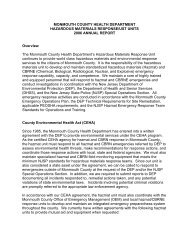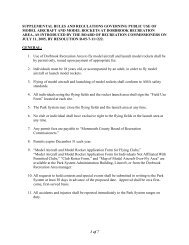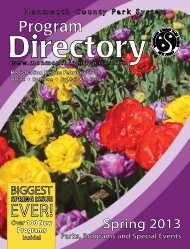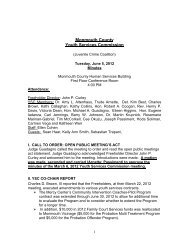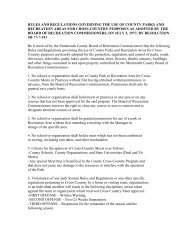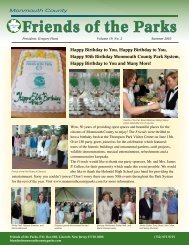DCF/DYFS Case Practice Improvement Overview
DCF/DYFS Case Practice Improvement Overview
DCF/DYFS Case Practice Improvement Overview
You also want an ePaper? Increase the reach of your titles
YUMPU automatically turns print PDFs into web optimized ePapers that Google loves.
New JerseyDepartment of Children and Families<strong>DCF</strong> / <strong>DYFS</strong><strong>Case</strong> <strong>Practice</strong> <strong>Improvement</strong> <strong>Overview</strong>Community Information MeetingKimberly S. Ricketts, CommissionerDepartment of Children and FamiliesChristine Mozes, Director<strong>DCF</strong>, Division of Youth and Family Services
<strong>DCF</strong> CASE PRACTICEStrengthening case practice,engaging families tosee a child notjust as he is…FAMILYFOCUSBut as strong ashis family canbecome.
The federal lawsuit recognizes that reform requiresa focused and staged process to achieve results:1 st Focus on the FundamentalsCreate the conditions that are pre‐requisitesto…2 nd Implementing Change in the Culture of <strong>Practice</strong>Move from a case management servicedelivery model to a strength‐based, familycentered, child focused model. Then, <strong>DYFS</strong>can…3 rd Deliver ResultsWith improved outcomes for children andfamilies.
What are the fundamentals?• Hire and train staff & achieve caseloadstandards• Expand services & reduce inappropriateplacements• Grow the pool of non‐kin resource families• Strengthen permanency processes &achieve adoption targets• Improve coordination between <strong>DYFS</strong>,DCBHS and DPCP• Sharpen the focus on safety
Recruiting New Foster and Adoptive Families
NJ Department of Children and Families
NJ Department of Children and Families
<strong>DCF</strong> <strong>Case</strong> <strong>Practice</strong>: Focusing on Families<strong>DCF</strong>/<strong>DYFS</strong> <strong>Case</strong> <strong>Practice</strong> model aims to see afamily’s whole life picture; including it’snatural supports (such as communityorganizations, family members, neighbors)and any issues effecting the family’s success(such as unemployment, substance abuse,housing, education, domestic violence,physical and mental health, etc.).
<strong>DCF</strong> <strong>Case</strong> <strong>Practice</strong>: Focusing on Families• Families must be our most powerfulally to ensure safety, improve wellbeingand achieve permanency forchildren.• Our case practice focuses us onengaging families in a robust andconstructive way.• With this practice, we focus onchildren while strengthening theirfamily and formal and natural supportsto help make good decisions effectingtheir safety and well‐being.
<strong>DCF</strong> <strong>Case</strong> <strong>Practice</strong>: Focusing on Families• Most families have the capacity to make positivechange with the support of individualized plans forsupports and services.• Engagement is the foundation to build trust andmutually beneficial relationships among children,youth, family members and <strong>DCF</strong>/<strong>DYFS</strong> staff.• We must listen to, assess andaddress the needs of children, youthand families in a respectful andresponsive manner that builds upontheir strengths.
Importance of Family Engagement• Engagement involves understanding theculture of a family and helping the familyidentify all potential supports.• Engagement does NOT mean we will loseobjectivity about safety risks to children.• Engagement means that, whenever safe andappropriate, youth and parents will beincluded in decision‐making about whatthey need to find solutions to family issuesand concerns about child safety.
Working with Family TeamsBuilding a family team has multiple benefits:• Teams are useful for gathering important informationabout the strengths and needs of families thatcontribute to the family’s current life situation.• Teams can assist the familythroughout the involvement with<strong>DCF</strong>/<strong>DYFS</strong> and help staff facilitatea successful service plan.• When it is time for the family toend its involvement with <strong>DYFS</strong>,the team can help support thefamily’s transition.
Who is Part of a Family Team?A family team ismade up of everyone important in the life of thechild, including interested family members,foster/adoptive parents, neighbors, friends, clergy,as well as representatives from the child’s formalsupport system, such as school staff, therapists,service providers, CASA, the court service and legalsystems.Parents, children and youth (whenage appropriate) and teammembers do become activeparticipants in making decisionsabout what services and supportsare needed, how and who shoulddeliver the services and how toidentify success.
How will we implement Our <strong>Case</strong> <strong>Practice</strong>?The implementation of this casepractice must be dynamic andcontinuous with constant attention toevaluating our progress along theway.To successfully implement this modelthroughout <strong>DCF</strong>, ownership of thereform must live at all levels of theorganization.
How will we implement Our <strong>Case</strong> <strong>Practice</strong>?SIXPRONGAPPROACH• Investing in strong leadership on all levels of <strong>DCF</strong>.• Pursuing an ambitious training plan that began in 2008 andwill continue into 2011.• Building models of case practice through completeimmersion in training and coaching for all Local Offices.• Developing services necessary to support a family‐centeredchild welfare practice in a transparent budget process.• Bridging the gap between the Divisions of Youth andFamily Services and Child Behavioral Health Services andPrevention and Community Partnerships.• Continued focus on the fundamentals of child safety, wellbeingand permanency.
The Road AheadAchieving this model of practicewith every child and family willtake time, but it is the standardthrough which practice andfuture commitments will beassessed and measured.<strong>DCF</strong> commits to an ongoingprocess of reevaluation of ourprogress against this model.
The Road AheadWe are excited to embark on thisimportant phase of reform. Wewelcome the opportunity to partnerwith the children and families weserve, supported by the widercommunity of stakeholders andproviders.While this work will be demanding,there is nothing more importantthan the work of learning to betterserve New Jersey’s vulnerablechildren and families –and wewelcome that challenge.
Engaging OutcomesEngaging skills demonstrate the ability to…Develop trusting relationships with families bydemonstrating genuineness, empathy, respect andcompetence by utilizing key skills and techniques todevelop these core competencies.Develop an effective working agreement.Effectiveness means that the family and worker agreeon the family’s problem, and underlying need thatmust be addressed to resolve the problem, as well astheir roles and responsibilities.(continued)
Engaging OutcomesEngaging skills demonstrate the ability to…Identify the family’s functional strengths andunderlying needs.Use a solution focused approach.Identify, engage and prepare family membersand their identified supports to work together.
Core Conditions ‐ Genuineness• Make sure your nonverbal behavior,voice tone and verbal responses matchand are congruent• Communicating trustworthiness andacceptance• Being able to express yourself naturallywithout artificial behaviors• Being open and receptive
Core Conditions ‐ Empathy• Recognizing the person’s experience,feelings and nonverbal communication• Communicating with words yourunderstanding of the person’sexperienceCommunicating with empathyresults in more openness in people!
Core Conditions ‐ Respect• Communicating warmth• Showing commitment• Recognizing and using aperson’s strengths• Being open‐minded
Core Conditions ‐ Competence• Listening• Commitment• Making progress toward goal• Follow through• Being open‐mined• Being knowledgeable• Providing and welcoming feedback
1) Build on a shared vision. Start with the places of strongagreement and resonance between yourself and the family. Beable to point to times when the family demonstrated strengthsrelated to this area of the work they have been doing. Help thefamily see that tracking and adaptation is a shared process toinsure that the family goals for the children are met.2) Identify what has gone according to the plan.Again, even if it means going non‐sequentially through the plan,identify what has worked and gone well. Help the parent and/orcaregivers operate from a sense of efficacy and success which cangive them strength and openness to look at where the plan hasgone awry.
3) Be honest about the areas that are tough. Acknowledgethe barriers to successfully overcoming such issues as substanceabuse, trauma recovery, mental illness, cognitive and developmentalchallenges. Help the family normalize relapse and failings as part ofthe process and as understandable.4) Create and recreate a shared commitment to live upto the children’s needs, even when it means revisioningthe original plan. Acknowledging that whilenormal, some relapses and vulnerabilities may exact too high a pricefrom children which can help parents have a deeper commitment tochange and a more thorough back‐up plan.
5) Remind the family that they can create and callupon their “team,” even if you don’t useformal teaming as practice. Many of our familiesspiral downwards because they are afraid to ask for help.Once you know that something is not working, part of the jobis to help the parent fix it; the other part is to help the parentfind other supports.



